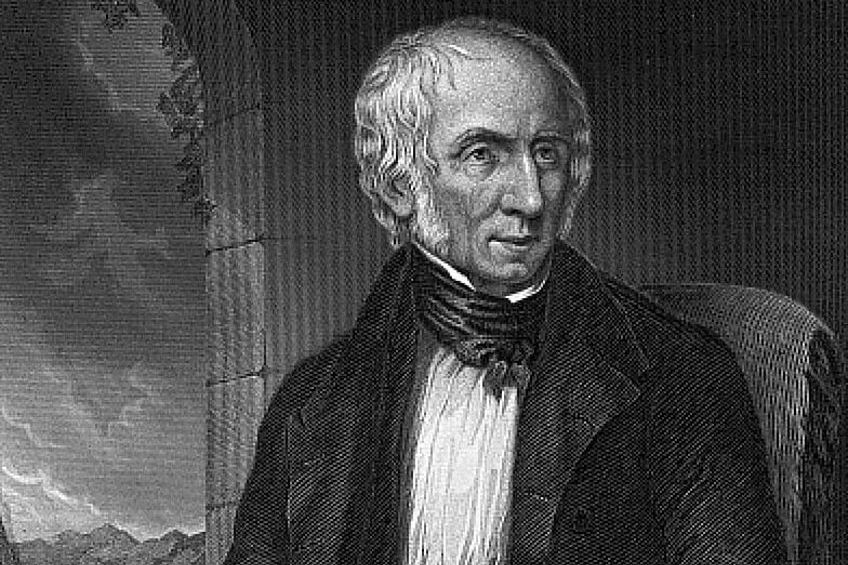William Wordsworth Poems – Explore the Best of the Famous Poet
There are many famous poets in the world, but when it comes to English literature, there are few as famous or influential as William Wordsworth. This poet was a central and founding figure in the Romantic movement, and his work would go on to influence so many other poets throughout that movement and beyond. Today, we will examine only a few of his poems to show why he came to be seen as such a titanic figure in the world of English poetry. If such a thing sounds at least somewhat interesting to you, let’s get reading!
A Few Poems by William Wordsworth
Few poets have been as influential to English literature as William Wordsworth. This figure was one of the central figures within the English Romantic movement and would even go on to be the Poet Laureate of the United Kingdom for the last seven years of his life. He produced many phenomenal poems over the course of his life, and, for this reason, choosing a small selection of William Wordsworth poems is a rather difficult thing to do. However, this is what we’ve committed to with the poems below.

This famous Romantic poet has many fantastic verses on display in his work, and he received many accolades during his career as a poet. So, let’s get over and done with this introductory bit because we have some poems to peruse. And the first of them will include a bit of a personal statement from myself because sometimes we need a bit of personality to help us navigate the world of poetry. Or at least, this is something that really helped me connect with my old literature students, because who wants cold and detached when you can be enthusiastic and maybe a little manic?
She Dwelt among the Untrodden Ways (1800)
| Date Published | 1800 |
| Type of Poem | Ballad |
| Rhyme Scheme | ABAB |
| Meter | Alternating iambic trimeter and tetrameter |
| Topic | Beauty |
She Dwelt among the Untrodden Ways is a beautiful poem that bears some similarity to My mistress’ eyes are nothing like the sun (1609) by William Shakespeare. The reason for this similarity is not in structure or form, but rather in tone. It discusses someone that the speaker loves and adores, and perceives as beautiful, yet it goes to some lengths to state that this person is not particularly beautiful. Instead, this person is either rather average-looking or not attractive at all. This can make the poem come across as somewhat mean-spirited, but the focus becomes inner beauty rather than external beauty.
This poem discusses the character of Lucy, who is a character that can be found in a number of poems by William Wordsworth.
This character is described as being someone who was like a beautiful flower or star, but only when there were no others to be seen. She did not stand out until one truly paid attention to her. The poem fixates on this idea of actually trying to understand someone rather than simply seeing the outer aspects of their appearance. Let’s go into a small personal tangent here. In terms of this particular poem, it was one of my favorites to teach when I used to teach the international Cambridge curriculum. This poem allowed me to speak to my students about how a poem could simultaneously make use of rather darker and unpleasant imagery while retaining a central meaning that is far more powerful than the usual kinds of themes one might find in an ordinary love poem. This does not emphasize the things we are taught to emphasize but rather sees someone more clearly. In my experience, this is a far better thing to teach a student than your average love poem.

Lucy Gray [or Solitude] (1800)
| Date Published | 1800 |
| Type of Poem | Narrative poem |
| Rhyme Scheme | ABAB |
| Meter | Variable |
| Topic | The story of Lucy Gray |
Lucy Gray [or Solitude] is a lengthy Narrative poem that serves as one of the earlier William Wordsworth poems that became immensely acclaimed. In this poem, the narrative about Lucy Gray that focuses on her journey. The story examines the way in which she became lost in the middle of a snowstorm on her journey home. The poem explores some of the themes for which William Wordsworth would become so well known, such as ideas concerning life itself and solitude.
While many of his most famous poems were far shorter in nature, this lengthy early poem would serve as a powerful text for the burgeoning poet.
Lines Composed a Few Miles above Tintern Abbey, On Revisiting the Banks of the Wye during a Tour. July 13, 1798 (1800)
| Date Published | 1800 |
| Type of Poem | Narrative poem |
| Rhyme Scheme | None |
| Meter | Iambic pentameter |
| Topic | Visiting the Wye River |
Lines Composed a Few Miles above Tintern Abbey, On Revisiting the Banks of the Wye during a Tour. July 13, 1798, is a poem with a title that is, quite simply, too long! However, regardless of the incredible length of the title itself, the poem is not necessarily all that long in comparison to some of the other poems for which William Wordsworth would become known. This poem describes his experience upon visiting the Wye River. This is located beside an ancient abbey that had long since been abandoned.
In terms of William Wordsworth’s poems, this one is a phenomenal meditation on the imagery of nature as it consumes what may have once been taken as human.

The World Is Too Much With Us (1807)
| Date Published | 1807 |
| Type of Poem | Sonnet |
| Rhyme Scheme | ABBA ABBA CDCDCD |
| Meter | Iambic pentameter |
| Topic | Nature and civilization |
The World Is Too Much With Us is a phenomenal example of a major theme that recurred in many William Wordsworth poems. The poem laid the blame for the way that humanity had become squarely at the feet of the Industrial Revolution and the changes that had come about as a result of it. The Romantics were known for their immense appreciation of the natural world, and this poem distilled that feeling into a sense of blame that modern civilization had severed humanity from nature and treated the two of them as immensely distinct entities utterly separated from one another.
The poem decries this change in human society and wishes for things to return to an earlier and better point.
Character of the Happy Warrior (1807)
| Date Published | 1807 |
| Type of Poem | Inspirational poem |
| Rhyme Scheme | AABB |
| Meter | Iambic pentameter |
| Topic | How to be a happy warrior |
Character of the Happy Warrior is a poem that is somewhat unlike many other William Wordsworth poems. In this case, the poem is set as a more inspirational tone. It explores this notion of a “happy warrior” archetype and attempts to present a more inspiring image to those who may wish to live in such a way. The poem itself took its own inspiration from the experiences of figures such as Lord Nelson, and it would go on to have its own influence on others.
It is not quite as famous as some of the other great poems by William Wordsworth, but it has remained a popular text long after the Romantic era has come to an end.
London, 1802 (1807)
| Date Published | 1807 |
| Type of Poem | Petrarchan sonnet |
| Rhyme Scheme | ABBA ABBA CDD ECE |
| Meter | Iambic pentameter |
| Topic | In praise of John Milton |
London, 1802 is another of the William Wordsworth poems with a certain fascination with the past. When it comes to this poem, the text fixates on the figure of John Milton. For those unfamiliar, and this can often be with older texts because references can age, this figure was a 17th-century poet who most famously wrote the long Christian epic poem, Paradise Lost.
When it comes to this William Wordsworth poem, he uses the idea of John Milton to explore a critique of the way the world had become during Wordsworth’s life and to instead celebrate a former glory of the country that should have been modeled after Milton rather than the reality that transpired instead.

The Solitary Reaper (1807)
| Date Published | 1807 |
| Type of Poem | Lyrical ballad |
| Rhyme Scheme | Variable |
| Meter | Iambic tetrameter |
| Topic | Listening to singing |
The Solitary Reaper is one of the many poems by William Wordsworth that makes use of autobiographical elements, although not quite to the same degree as the very last item on this particular list of poems. In this case, the poem is geared around the speaker’s recollection of an experience he had when he was younger. There was a woman singing in a field, and he heard it while remaining unmoving in his appreciation of the song. He could only listen. And while he did obviously leave that place, he never forgot the song that she sang.
This poem explores the kinds of themes on human individuality and emotion that would become such staples in Romantic poetry in general and Wordsworth’s poetry in particular.
My Heart Leaps Up (1807)
| Date Published | 1807 |
| Type of Poem | Lyric poem |
| Rhyme Scheme | ABCCABCDB |
| Meter | Iambic tetrameter |
| Topic | Love of nature |
My Heart Leaps Up is yet another William Wordsworth poem that focuses on the natural world. In this poem, the poet describes the speaker’s love and adoration for nature itself. While the poem does open with an image of a rainbow, it eventually extends to a further sense of natural wonder that eclipses the rainbow alone. Texts such as this would greatly contribute to the notion that the Romantic movement had a fascination and fixation on the natural world.
There was a certain spirituality attached to the natural world too, and this comes through in poems like this.
I Wandered Lonely as a Cloud (1815)
| Date Published | 1815 |
| Type of Poem | Lyric poem |
| Rhyme Scheme | ABABCC |
| Meter | Iambic tetrameter |
| Topic | Nature and memory |
I Wandered Lonely as a Cloud is a rather fascinating poem because of its changing reception. When the poem was first published, it was seen as a rather weak text that was heavily criticized by Wordsworth’s contemporaries. However, it has now become seen as perhaps his most famous poem. It is, like many of the most famous poems by William Wordsworth, an examination of the natural world. In more particular terms, it focuses on how the natural world has a major influence and impact on our memory and development. The poem’s principal image has become its best-known feature, and that is the sight of the field of daffodils. They have become one of the things most associated with Wordsworth, and they are shown to remain in his memory for years upon years after he first saw them.
This poem may be his most famous, but the next and final poem is perhaps his greatest.

The Prelude (1850)
| Date Published | 1850 |
| Type of Poem | Autobiographical poem |
| Rhyme Scheme | Blank verse |
| Meter | Mostly iambic pentameter |
| Topic | Wordsworth’s life |
The Prelude is often considered to be one of the greatest of all the works that ever came from this poet’s illustrious life. It is the last item on this list because it did come about later in his life. In terms of William Wordsworth’s poems, this text is one that examines and explores his life in an autobiographical means. While there certainly have been autobiographical elements in earlier poems, this text takes full stock of the early years of his life in a more holistic sense.
The poem traces his development as a young poet and moves through several of the major experiences of his life. The Romantic period was often one that was focused on individuality and emotionality, and this poem is a perfect example of that ethos.

Today, we have had a nice little look at a number of famous William Wordsworth poems, and while these have been some of the best-known poems he produced, there are many more out there! This list should have provided a good taster of what all is out there. So, if you want more poetry with a focus on the individual, emotionality, and the natural world, there are many other William Wordsworth poems out there to explore. In addition, you could always peruse the works that were ultimately inspired by the poems of William Wordsworth!
Frequently Asked Questions
Who Was William Wordsworth?
William Wordsworth was a famous Romantic poet who was born in Cockermouth, Cumberland in England. He would go on to become an immensely acclaimed figure in English poetry during his life, and he would ultimately pass away in 1850 as the Poet Laureate of the United Kingdom. He would come to be known for his dedication to an appreciation of nature and a desire to place the divine securely within poetic works. He, along with Samuel Taylor Coleridge, is seen as the founder of what would become the Romantic movement.
What Era Was William Wordsworth a Part Of?
William Wordsworth was a prominent member of the English Romantic movement. This was a movement that spanned from the 18th to 19th centuries and would focus on elements such as the natural world, individualism, and emotion. It was often opposed to ideas such as human civilization and the effects that it had on the world. William Wordsworth’s poems would have a major influence on this era, and the era itself would go on to be immensely inspiring for many other writers.
How Influential Was William Wordsworth?
William Wordsworth was one of the most influential poets of the 19th century. His work would have a profound influence within the immediate aftermath of his first poems’ publication on the literary culture of the time. Practically every other poet who would enter into the Romantic movement would draw at least some level of inspiration from the poems of William Wordsworth. This contribution alone would have made him a major figure in English literature going forward because his influence touched so many others who would go on to be immensely dominate in their own fields. So, his influence can be seen as exponential. Those who he influenced went on to do the same with others who influenced others, and so on.
Why Did William Wordsworth Become the Poet Laureate?
William Wordsworth is often considered to be one of the greatest poets who has ever made contributions to English literature. He was also very much not one of those poets who was only recognized after his death. He was considered to be a foundational member of the Romantic movement in general, and he also outlived many of the other most famous members of the movement. He was ultimately made into the Poet Laureate of the United Kingdom because he was definitively recognized as a central figure in English poetry during his life.
What Are Some Famous William Wordsworth Poems?
When it comes to William Wordsworth’s poems, there are so many famous examples to choose from, but some of the best-known include poems such as She Dwelt among the Untrodden Ways (1800), The Solitary Reaper (1807), and I Wandered Lonely as a Cloud (1815). However, there are many more poems that he wrote. William Wordsworth survived far longer than many of the other most famous Romantic poets, and so he was still writing poems into his old age.
Justin van Huyssteen is a freelance writer, novelist, and academic originally from Cape Town, South Africa. At present, he has a bachelor’s degree in English and literary theory and an honor’s degree in literary theory. He is currently working towards his master’s degree in literary theory with a focus on animal studies, critical theory, and semiotics within literature. As a novelist and freelancer, he often writes under the pen name L.C. Lupus.
Justin’s preferred literary movements include modern and postmodern literature with literary fiction and genre fiction like sci-fi, post-apocalyptic, and horror being of particular interest. His academia extends to his interest in prose and narratology. He enjoys analyzing a variety of mediums through a literary lens, such as graphic novels, film, and video games.
Justin is working for artincontext.org as an author and content writer since 2022. He is responsible for all blog posts about architecture, literature and poetry.
Learn more about Justin van Huyssteen and the Art in Context Team.
Cite this Article
Justin, van Huyssteen, “William Wordsworth Poems – Explore the Best of the Famous Poet.” Art in Context. January 17, 2024. URL: https://artincontext.org/william-wordsworth-poems/
van Huyssteen, J. (2024, 17 January). William Wordsworth Poems – Explore the Best of the Famous Poet. Art in Context. https://artincontext.org/william-wordsworth-poems/
van Huyssteen, Justin. “William Wordsworth Poems – Explore the Best of the Famous Poet.” Art in Context, January 17, 2024. https://artincontext.org/william-wordsworth-poems/.









